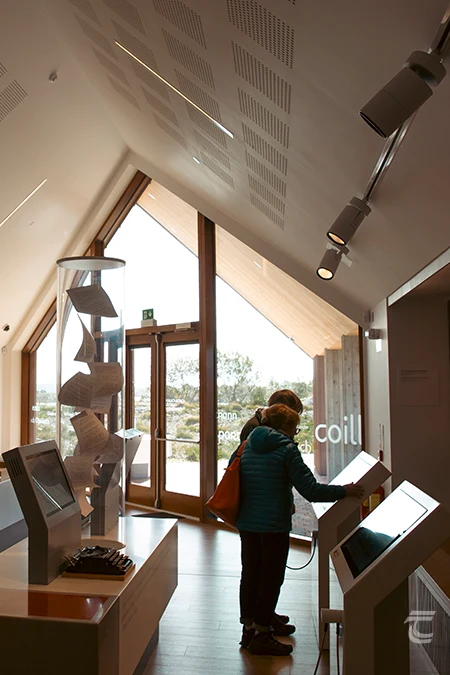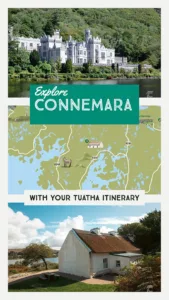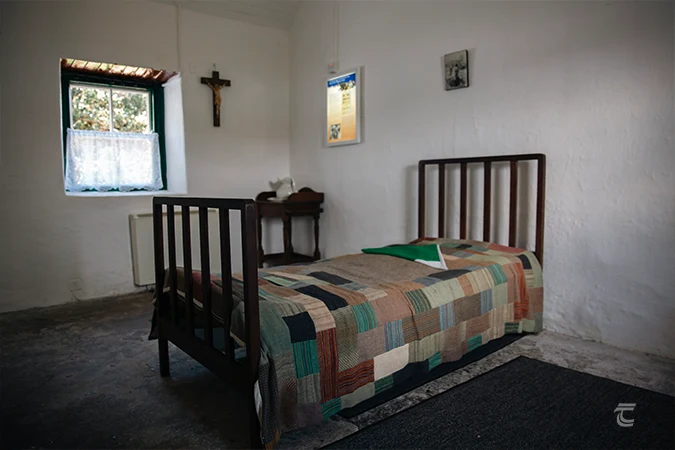Pearse Cottage • Teach an Phiarsaigh
Teach an Phiarsaigh or Pearse Cottage is set in the beautifully picturesque Connemara landscape. This charming cottage was the summer residence of Patrick Pearse (1879–1916), one of the leaders of the 1916 Easter Rising. The cottage itself dates to around 1870, its steeply pitching thatched roof and rural setting make it a tranquil and peaceful place. In contrast to the cottage, its most famous resident had a turbulent life. Patrick Pearse was born in Dublin on the 10th November 1879. He was the son of James Pearse, a stone carver and monumental sculptor, and his wife Margaret Brady. Pearse was highly educated, and studied Irish, English, and French at University College Dublin, and law at Trinity College. He became a passionate advocate for the Irish language, and saw it as a key part of Irish identity, joining the Gaelic League by the time he was 17. Pearse shared Cardinal John Henry Newman’s vision of a future for Ireland as a bastion of world scholarship and intellectual and artistic endeavours.
Pearse was something of a prodigy, and published papers on ‘Gaelic prose literature’, ‘The intellectual future of the Gael’, and ‘The folk songs of Ireland’ before he was 18. Pearse would go on to author a number of short stories in Irish, including the eldritch ‘Dearg-a-Daol‘ that always comes to my mind when I see a rove beetle. Many of his writings were informed by the landscape and culture of the Connemara landscapes around Ros Muc. He had developed a strong affinity with the area, and purchased this land near Loch Eileabhrach in 1905. He built the cottage in 1909, and had it thatched in the style of a poor country dwelling. On his visits between 1903 and 1915, Pearse spent time in the cabins of the poor, soaking up the folklore which found its way into his writings. The cottage became his retreat where he could escape the pressures of Dublin to immerse himself in this storied landscape.
For practical information about visiting this site Click Here
Teach an Phiarsaigh or Pearse Cottage is set in the beautifully picturesque Connemara landscape. This charming cottage was the summer residence of Patrick Pearse (1879–1916), one of the leaders of the 1916 Easter Rising. The cottage itself dates to around 1870, its steeply pitching thatched roof and rural setting make it a tranquil and peaceful place. In contrast to the cottage, its most famous resident had a turbulent life. Patrick Pearse was born in Dublin on the 10th November 1879. He was the son of James Pearse, a stone carver and monumental sculptor, and his wife Margaret Brady. Pearse was highly educated, and studied Irish, English, and French at University College Dublin, and law at Trinity College. He became a passionate advocate for the Irish language, and saw it as a key part of Irish identity, joining the Gaelic League by the time he was 17. Pearse shared Cardinal John Henry Newman’s vision of a future for Ireland as a bastion of world scholarship and intellectual and artistic endeavours.
Pearse was something of a prodigy, and published papers on ‘Gaelic prose literature’, ‘The intellectual future of the Gael’, and ‘The folk songs of Ireland’ before he was 18. Pearse would go on to author a number of short stories in Irish, including the eldritch ‘Dearg-a-Daol‘ that always comes to my mind when I see a rove beetle. Many of his writings were informed by the landscape and culture of the Connemara landscapes around Ros Muc. He had developed a strong affinity with the area, and purchased this land near Loch Eileabhrach in 1905. He built the cottage in 1909, and had it thatched in the style of a poor country dwelling. On his visits between 1903 and 1915, Pearse spent time in the cabins of the poor, soaking up the folklore which found its way into his writings. The cottage became his retreat where he could escape the pressures of Dublin to immerse himself in this storied landscape.
For practical information about visiting this site Click Here

Patrick Pearse Cottage Teach an Phiarsaigh set in the beautiful Connemara landscape • Galway
A Cultural Retreat

Inside Ionad Cultúrtha an Phiarsaigh, the modern visitor and cultural centre • Connemara
As well as a retreat, Pearse held a summer school here for his pupils from St Enda’s in Dublin. One of his former pupils, who attended the summer school in 1915, later wrote of his visits there.
‘The Twelve Pins came in sight and Pearse waved his hand here and there over the land, naming lake, mountain and district away to the Joyce Country under its purple mist.’
Pearse truly loved this landscape and the folklore and storytelling traditions of the area. It was within this cottage that he penned the funeral oration for O’Donovan Rossa, which finished with the stirring words:
‘‘They think that they have pacified Ireland. They think that they have purchased half of us and intimidated the other half. They think that they have foreseen everything, think that they have provided against everything; but the fools, the fools, the fools! They have left us our Fenian dead, and, while Ireland holds these graves, Ireland unfree shall never be at peace.’’
Pearse passionately believed in the cause of Irish freedom, and after he joined the Irish Republican Brotherhood (IRB) in 1913, he became one of the most prominent figures in the independence movement. When the Easter Rising began on Monday 24 April 1916, it was Pearse who read the Proclamation of the Irish Republic outside the General Post Office, as he was chosen as the President of the Republic. However, the Easter Rising ended after six days of fighting, when Pearse issued the order to surrender in an effort to curtail civilian casualties. Pearse and fourteen other leaders, including his brother Willie, were court-martialled and executed by firing squad.

Inside Ionad Cultúrtha an Phiarsaigh, the modern visitor and cultural centre • Connemara
After Pearse’s execution on May 3rd, 1916, his cottage passed to his mother Margaret. In 1921 it was burned down by the Black and Tans and Auxiliaries during the Irish War of Independence. The cottage was lovingly restored, before Pearse’s sisters Senator Margaret Pearse and Mary Brigid Pearse handed the cottage to the State in 1943.
A wonderful visitor and cultural centre has been recently constructed near the cottage, and houses interactive displays that beautifully weave the tale of this important figure in Irish history, and his love of Connemara.
Upper left: Pearse Cottage • Lower left: the interior of the cottage • Right: the modern visitor centre Ionad Cultúrtha an Phiarsaigh
Top: Pearse Cottage • Middle: the modern visitor centre Ionad Cultúrtha an Phiarsaigh • Bottom: the interior of the cottage
Explore more sites on the Wild Atlantic Way




